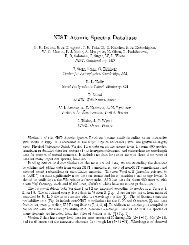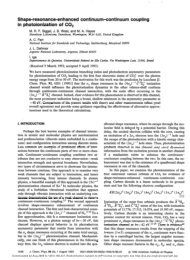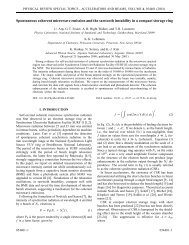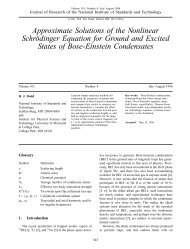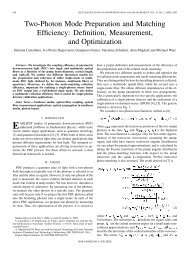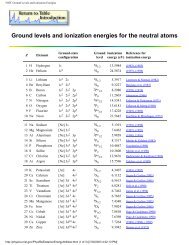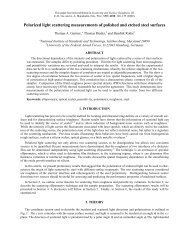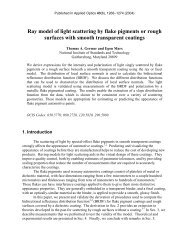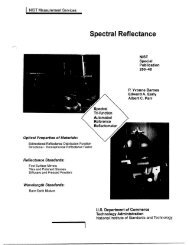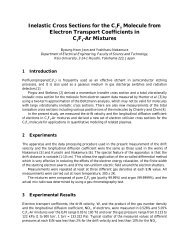Fundamental Physical Constants — Extensive Listing
Fundamental Physical Constants — Extensive Listing
Fundamental Physical Constants — Extensive Listing
You also want an ePaper? Increase the reach of your titles
YUMPU automatically turns print PDFs into web optimized ePapers that Google loves.
<strong>Fundamental</strong> <strong>Physical</strong> <strong>Constants</strong> <strong>—</strong> <strong>Extensive</strong> <strong>Listing</strong> Relative std.<br />
Quantity Symbol Value Unit uncert. ur<br />
UNIVERSAL<br />
speed of light in vacuum c, c0 299 792 458 m s −1 (exact)<br />
magnetic constant µ0 4π × 10 −7 N A −2<br />
= 12.566 370 614... × 10 −7 N A −2 (exact)<br />
electric constant 1/µ0c 2 ɛ0 8.854 187 817... × 10 −12 F m −1 (exact)<br />
characteristic impedance<br />
of vacuum µ0/ɛ0 = µ0c Z0 376.730 313 461... Ω (exact)<br />
Newtonian constant<br />
of gravitation G 6.6742(10) × 10 −11 m 3 kg −1 s −2 1.5 × 10 −4<br />
G/¯hc 6.7087(10) × 10 −39 (GeV/c 2 ) −2 1.5 × 10 −4<br />
Planck constant h 6.626 0693(11) × 10 −34 J s 1.7 × 10 −7<br />
in eV s 4.135 667 43(35) × 10 −15 eV s 8.5 × 10 −8<br />
h/2π ¯h 1.054 571 68(18) × 10 −34 J s 1.7 × 10 −7<br />
in eV s 6.582 119 15(56) × 10 −16 eV s 8.5 × 10 −8<br />
¯hc in Mev fm 197.326 968(17) MeV fm 8.5 × 10 −8<br />
Planck mass (¯hc/G) 1/2 mP 2.176 45(16) × 10 −8 kg 7.5 × 10 −5<br />
Planck temperature (¯hc 5 /G) 1/2 /k TP 1.416 79(11) × 10 32 K 7.5 × 10 −5<br />
Planck length ¯h/mPc = (¯hG/c 3 ) 1/2 lP 1.616 24(12) × 10 −35 m 7.5 × 10 −5<br />
Planck time lP/c = (¯hG/c 5 ) 1/2 tP 5.391 21(40) × 10 −44 s 7.5 × 10 −5<br />
ELECTROMAGNETIC<br />
elementary charge e 1.602 176 53(14) × 10 −19 C 8.5 × 10 −8<br />
e/h 2.417 989 40(21) × 10 14 A J −1 8.5 × 10 −8<br />
magnetic flux quantum h/2e Φ0 2.067 833 72(18) × 10−15 Wb 8.5 × 10−8 conductance quantum 2e2 /h G0 7.748 091 733(26) × 10−5 S 3.3 × 10−9 inverse of conductance quantum G −1<br />
0 12 906.403 725(43) Ω 3.3 × 10−9 Josephson constant1 2e/h KJ 483 597.879(41) × 109 Hz V−1 8.5 × 10−8 von Klitzing constant2 h/e2 = µ0c/2α RK 25 812.807 449(86) Ω 3.3 × 10−9 Bohr magneton e¯h/2me µB 927.400 949(80) × 10 −26 J T −1 8.6 × 10 −8<br />
in eV T −1 5.788 381 804(39) × 10 −5 eV T −1 6.7 × 10 −9<br />
µB/h 13.996 2458(12) × 10 9 Hz T −1 8.6 × 10 −8<br />
µB/hc 46.686 4507(40) m −1 T −1 8.6 × 10 −8<br />
µB/k 0.671 7131(12) K T −1 1.8 × 10 −6<br />
nuclear magneton e¯h/2mp µN 5.050 783 43(43) × 10 −27 J T −1 8.6 × 10 −8<br />
in eV T −1 3.152 451 259(21) × 10 −8 eV T −1 6.7 × 10 −9<br />
µN/h 7.622 593 71(65) MHz T −1 8.6 × 10 −8<br />
µN/hc 2.542 623 58(22) × 10 −2 m −1 T −1 8.6 × 10 −8<br />
µN/k 3.658 2637(64) × 10 −4 K T −1 1.8 × 10 −6<br />
ATOMIC AND NUCLEAR<br />
General<br />
From: http://physics.nist.gov/constants<br />
Page 1 Source: Peter J. Mohr and Barry N. Taylor, CODATA Recommended Values of the <strong>Fundamental</strong> <strong>Physical</strong><br />
<strong>Constants</strong>: 2002, published in Review of Modern Physics 77, 1 (2005).
<strong>Fundamental</strong> <strong>Physical</strong> <strong>Constants</strong> <strong>—</strong> <strong>Extensive</strong> <strong>Listing</strong><br />
From: http://physics.nist.gov/constants<br />
Relative std.<br />
Quantity Symbol Value Unit uncert. ur<br />
fine-structure constant e 2 /4πɛ0¯hc α 7.297 352 568(24) × 10 −3 3.3 × 10 −9<br />
inverse fine-structure constant α −1 137.035 999 11(46) 3.3 × 10 −9<br />
Rydberg constant α 2 mec/2h R∞ 10 973 731.568 525(73) m −1 6.6 × 10 −12<br />
R∞c 3.289 841 960 360(22) × 10 15 Hz 6.6 × 10 −12<br />
R∞hc 2.179 872 09(37) × 10 −18 J 1.7 × 10 −7<br />
R∞hc in eV 13.605 6923(12) eV 8.5 × 10 −8<br />
Bohr radius α/4πR∞ = 4πɛ0¯h 2 /mee 2 a0 0.529 177 2108(18) × 10 −10 m 3.3 × 10 −9<br />
Hartree energy e 2 /4πɛ0a0 = 2R∞hc<br />
= α 2 mec 2 Eh 4.359 744 17(75) × 10 −18 J 1.7 × 10 −7<br />
in eV 27.211 3845(23) eV 8.5 × 10 −8<br />
quantum of circulation h/2me 3.636 947 550(24) × 10 −4 m 2 s −1 6.7 × 10 −9<br />
h/me 7.273 895 101(48) × 10 −4 m 2 s −1 6.7 × 10 −9<br />
Electroweak<br />
Fermi coupling constant 3 GF/(¯hc) 3 1.166 39(1) × 10 −5 GeV −2 8.6 × 10 −6<br />
weak mixing angle 4 θW (on-shell scheme)<br />
sin 2 θW = s 2 W ≡ 1 − (mW/mZ) 2 sin 2 θW 0.222 15(76) 3.4 × 10 −3<br />
Electron, e −<br />
electron mass me 9.109 3826(16) × 10 −31 kg 1.7 × 10 −7<br />
in u, me = Ar(e) u (electron<br />
relative atomic mass times u) 5.485 799 0945(24) × 10 −4 u 4.4 × 10 −10<br />
energy equivalent mec 2 8.187 1047(14) × 10 −14 J 1.7 × 10 −7<br />
in MeV 0.510 998 918(44) MeV 8.6 × 10 −8<br />
electron-muon mass ratio me/mμ 4.836 331 67(13) × 10 −3 2.6 × 10 −8<br />
electron-tau mass ratio me/mτ 2.875 64(47) × 10 −4 1.6 × 10 −4<br />
electron-proton mass ratio me/mp 5.446 170 2173(25) × 10 −4 4.6 × 10 −10<br />
electron-neutron mass ratio me/mn 5.438 673 4481(38) × 10 −4 7.0 × 10 −10<br />
electron-deuteron mass ratio me/md 2.724 437 1095(13) × 10 −4 4.8 × 10 −10<br />
electron to alpha particle mass ratio me/mα 1.370 933 555 75(61) × 10 −4 4.4 × 10 −10<br />
electron charge to mass quotient −e/me −1.758 820 12(15) × 10 11 C kg −1 8.6 × 10 −8<br />
electron molar mass NAme M(e), Me 5.485 799 0945(24) × 10 −7 kg mol −1 4.4 × 10 −10<br />
Compton wavelength h/mec λC 2.426 310 238(16) × 10 −12 m 6.7 × 10 −9<br />
λC/2π = αa0 = α 2 /4πR∞ λC 386.159 2678(26) × 10 −15 m 6.7 × 10 −9<br />
classical electron radius α 2 a0 re 2.817 940 325(28) × 10 −15 m 1.0 × 10 −8<br />
Thomson cross section (8π/3)r 2 e σe 0.665 245 873(13) × 10 −28 m 2 2.0 × 10 −8<br />
electron magnetic moment µe −928.476 412(80) × 10 −26 J T −1 8.6 × 10 −8<br />
to Bohr magneton ratio µe/µB −1.001 159 652 1859(38) 3.8 × 10 −12<br />
to nuclear magneton ratio µe/µN −1838.281 971 07(85) 4.6 × 10 −10<br />
electron magnetic moment<br />
anomaly |µe|/µB − 1 ae 1.159 652 1859(38) × 10 −3 3.2 × 10 −9<br />
electron g-factor −2(1 + ae) ge −2.002 319 304 3718(75) 3.8 × 10 −12<br />
Page 2 Source: Peter J. Mohr and Barry N. Taylor, CODATA Recommended Values of the <strong>Fundamental</strong> <strong>Physical</strong><br />
<strong>Constants</strong>: 2002, published in Review of Modern Physics 77, 1 (2005).
<strong>Fundamental</strong> <strong>Physical</strong> <strong>Constants</strong> <strong>—</strong> <strong>Extensive</strong> <strong>Listing</strong> Relative std.<br />
Quantity Symbol Value Unit uncert. ur<br />
electron-muon<br />
magnetic moment ratio µe/µμ 206.766 9894(54) 2.6 × 10 −8<br />
electron-proton<br />
magnetic moment ratio µe/µp −658.210 6862(66) 1.0 × 10 −8<br />
electron to shielded proton<br />
magnetic moment ratio µe/µ ′ p −658.227 5956(71) 1.1 × 10 −8<br />
(H2O, sphere, 25 ◦ C)<br />
electron-neutron<br />
magnetic moment ratio µe/µn 960.920 50(23) 2.4 × 10 −7<br />
electron-deuteron<br />
magnetic moment ratio µe/µd −2143.923 493(23) 1.1 × 10 −8<br />
electron to shielded helion 5<br />
magnetic moment ratio µe/µ ′ h 864.058 255(10) 1.2 × 10 −8<br />
(gas, sphere, 25 ◦ C)<br />
electron gyromagnetic ratio 2|µe|/¯h γe 1.760 859 74(15) × 10 11 s −1 T −1 8.6 × 10 −8<br />
γe/2π 28 024.9532(24) MHz T −1 8.6 × 10 −8<br />
Muon, µ −<br />
muon mass mμ 1.883 531 40(33) × 10 −28 kg 1.7 × 10 −7<br />
in u, mμ = Ar(μ) u (muon<br />
relative atomic mass times u) 0.113 428 9264(30) u 2.6 × 10 −8<br />
energy equivalent mμc 2 1.692 833 60(29) × 10 −11 J 1.7 × 10 −7<br />
in MeV 105.658 3692(94) MeV 8.9 × 10 −8<br />
muon-electron mass ratio mμ/me 206.768 2838(54) 2.6 × 10 −8<br />
muon-tau mass ratio mμ/mτ 5.945 92(97) × 10 −2 1.6 × 10 −4<br />
muon-proton mass ratio mμ/mp 0.112 609 5269(29) 2.6 × 10 −8<br />
muon-neutron mass ratio mμ/mn 0.112 454 5175(29) 2.6 × 10 −8<br />
muon molar mass NAmμ M(μ), Mμ 0.113 428 9264(30) × 10 −3 kg mol −1 2.6 × 10 −8<br />
muon Compton wavelength h/mμc λC,μ 11.734 441 05(30) × 10 −15 m 2.5 × 10 −8<br />
λC,μ/2π λC,μ 1.867 594 298(47) × 10 −15 m 2.5 × 10 −8<br />
muon magnetic moment µμ −4.490 447 99(40) × 10 −26 J T −1 8.9 × 10 −8<br />
to Bohr magneton ratio µμ/µB −4.841 970 45(13) × 10 −3 2.6 × 10 −8<br />
to nuclear magneton ratio µμ/µN −8.890 596 98(23) 2.6 × 10 −8<br />
muon magnetic moment anomaly<br />
|µμ|/(e¯h/2mμ) − 1 aμ 1.165 919 81(62) × 10 −3 5.3 × 10 −7<br />
muon g-factor −2(1 + aμ) gμ −2.002 331 8396(12) 6.2 × 10 −10<br />
muon-proton<br />
magnetic moment ratio µμ/µp −3.183 345 118(89) 2.8 × 10 −8<br />
Tau, τ −<br />
tau mass 6 mτ 3.167 77(52) × 10 −27 kg 1.6 × 10 −4<br />
in u, mτ = Ar(τ) u (tau<br />
relative atomic mass times u) 1.907 68(31) u 1.6 × 10 −4<br />
energy equivalent mτc 2 2.847 05(46) × 10 −10 J 1.6 × 10 −4<br />
From: http://physics.nist.gov/constants<br />
Page 3 Source: Peter J. Mohr and Barry N. Taylor, CODATA Recommended Values of the <strong>Fundamental</strong> <strong>Physical</strong><br />
<strong>Constants</strong>: 2002, published in Review of Modern Physics 77, 1 (2005).
<strong>Fundamental</strong> <strong>Physical</strong> <strong>Constants</strong> <strong>—</strong> <strong>Extensive</strong> <strong>Listing</strong> Relative std.<br />
Quantity Symbol Value Unit uncert. ur<br />
in MeV 1776.99(29) MeV 1.6 × 10 −4<br />
tau-electron mass ratio mτ/me 3477.48(57) 1.6 × 10 −4<br />
tau-muon mass ratio mτ/mμ 16.8183(27) 1.6 × 10 −4<br />
tau-proton mass ratio mτ/mp 1.893 90(31) 1.6 × 10 −4<br />
tau-neutron mass ratio mτ/mn 1.891 29(31) 1.6 × 10 −4<br />
tau molar mass NAmτ M(τ), Mτ 1.907 68(31) × 10 −3 kg mol −1 1.6 × 10 −4<br />
tau Compton wavelength h/mτc λC,τ 0.697 72(11) × 10 −15 m 1.6 × 10 −4<br />
λC,τ/2π λC,τ 0.111 046(18) × 10 −15 m 1.6 × 10 −4<br />
Proton, p<br />
From: http://physics.nist.gov/constants<br />
proton mass mp 1.672 621 71(29) × 10 −27 kg 1.7 × 10 −7<br />
in u, mp = Ar(p) u (proton<br />
relative atomic mass times u) 1.007 276 466 88(13) u 1.3 × 10 −10<br />
energy equivalent mpc 2 1.503 277 43(26) × 10 −10 J 1.7 × 10 −7<br />
in MeV 938.272 029(80) MeV 8.6 × 10 −8<br />
proton-electron mass ratio mp/me 1836.152 672 61(85) 4.6 × 10 −10<br />
proton-muon mass ratio mp/mμ 8.880 243 33(23) 2.6 × 10 −8<br />
proton-tau mass ratio mp/mτ 0.528 012(86) 1.6 × 10 −4<br />
proton-neutron mass ratio mp/mn 0.998 623 478 72(58) 5.8 × 10 −10<br />
proton charge to mass quotient e/mp 9.578 833 76(82) × 10 7 C kg −1 8.6 × 10 −8<br />
proton molar mass NAmp M(p), Mp 1.007 276 466 88(13) × 10 −3 kg mol −1 1.3 × 10 −10<br />
proton Compton wavelength h/mpc λC,p 1.321 409 8555(88) × 10 −15 m 6.7 × 10 −9<br />
λC,p/2π λC,p 0.210 308 9104(14) × 10 −15 m 6.7 × 10 −9<br />
proton rms charge radius Rp 0.8750(68) × 10 −15 m 7.8 × 10 −3<br />
proton magnetic moment µp 1.410 606 71(12) × 10 −26 J T −1 8.7 × 10 −8<br />
to Bohr magneton ratio µp/µB 1.521 032 206(15) × 10 −3 1.0 × 10 −8<br />
to nuclear magneton ratio µp/µN 2.792 847 351(28) 1.0 × 10 −8<br />
proton g-factor 2µp/µN gp 5.585 694 701(56) 1.0 × 10 −8<br />
proton-neutron<br />
magnetic moment ratio µp/µn −1.459 898 05(34) 2.4 × 10 −7<br />
shielded proton magnetic moment µ ′ p 1.410 570 47(12) × 10 −26 J T −1 8.7 × 10 −8<br />
(H2O, sphere, 25 ◦ C)<br />
to Bohr magneton ratio µ ′ p/µB 1.520 993 132(16) × 10 −3 1.1 × 10 −8<br />
to nuclear magneton ratio µ ′ p/µN 2.792 775 604(30) 1.1 × 10 −8<br />
proton magnetic shielding<br />
correction 1 − µ ′ p/µp σ ′ p 25.689(15) × 10 −6 5.7 × 10 −4<br />
(H2O, sphere, 25 ◦ C)<br />
proton gyromagnetic ratio 2µp/¯h γp 2.675 222 05(23) × 10 8 s −1 T −1 8.6 × 10 −8<br />
γp/2π 42.577 4813(37) MHz T −1 8.6 × 10 −8<br />
shielded proton gyromagnetic<br />
ratio 2µ ′ p/¯h γ ′ p 2.675 153 33(23) × 10 8 s −1 T −1 8.6 × 10 −8<br />
(H2O, sphere, 25 ◦ C)<br />
Page 4 Source: Peter J. Mohr and Barry N. Taylor, CODATA Recommended Values of the <strong>Fundamental</strong> <strong>Physical</strong><br />
<strong>Constants</strong>: 2002, published in Review of Modern Physics 77, 1 (2005).
From: http://physics.nist.gov/constants<br />
<strong>Fundamental</strong> <strong>Physical</strong> <strong>Constants</strong> <strong>—</strong> <strong>Extensive</strong> <strong>Listing</strong> Relative std.<br />
Quantity Symbol Value Unit uncert. ur<br />
γ ′ p/2π 42.576 3875(37) MHz T −1 8.6 × 10 −8<br />
Neutron, n<br />
neutron mass mn 1.674 927 28(29) × 10 −27 kg 1.7 × 10 −7<br />
in u, mn = Ar(n) u (neutron<br />
relative atomic mass times u) 1.008 664 915 60(55) u 5.5 × 10 −10<br />
energy equivalent mnc 2 1.505 349 57(26) × 10 −10 J 1.7 × 10 −7<br />
in MeV 939.565 360(81) MeV 8.6 × 10 −8<br />
neutron-electron mass ratio mn/me 1838.683 6598(13) 7.0 × 10 −10<br />
neutron-muon mass ratio mn/mμ 8.892 484 02(23) 2.6 × 10 −8<br />
neutron-tau mass ratio mn/mτ 0.528 740(86) 1.6 × 10 −4<br />
neutron-proton mass ratio mn/mp 1.001 378 418 70(58) 5.8 × 10 −10<br />
neutron molar mass NAmn M(n), Mn 1.008 664 915 60(55) × 10 −3 kg mol −1 5.5 × 10 −10<br />
neutron Compton wavelength h/mnc λC,n 1.319 590 9067(88) × 10 −15 m 6.7 × 10 −9<br />
λC,n/2π λC,n 0.210 019 4157(14) × 10 −15 m 6.7 × 10 −9<br />
neutron magnetic moment µn −0.966 236 45(24) × 10 −26 J T −1 2.5 × 10 −7<br />
to Bohr magneton ratio µn/µB −1.041 875 63(25) × 10 −3 2.4 × 10 −7<br />
to nuclear magneton ratio µn/µN −1.913 042 73(45) 2.4 × 10 −7<br />
neutron g-factor 2µn/µN gn −3.826 085 46(90) 2.4 × 10 −7<br />
neutron-electron<br />
magnetic moment ratio µn/µe 1.040 668 82(25) × 10 −3 2.4 × 10 −7<br />
neutron-proton<br />
magnetic moment ratio µn/µp −0.684 979 34(16) 2.4 × 10 −7<br />
neutron to shielded proton<br />
magnetic moment ratio µn/µ ′ p −0.684 996 94(16) 2.4 × 10 −7<br />
(H2O, sphere, 25 ◦ C)<br />
neutron gyromagnetic ratio 2|µn|/¯h γn 1.832 471 83(46) × 10 8 s −1 T −1 2.5 × 10 −7<br />
γn/2π 29.164 6950(73) MHz T −1 2.5 × 10 −7<br />
Deuteron, d<br />
deuteron mass md 3.343 583 35(57) × 10 −27 kg 1.7 × 10 −7<br />
in u, md = Ar(d) u (deuteron<br />
relative atomic mass times u) 2.013 553 212 70(35) u 1.7 × 10 −10<br />
energy equivalent mdc 2 3.005 062 85(51) × 10 −10 J 1.7 × 10 −7<br />
in MeV 1875.612 82(16) MeV 8.6 × 10 −8<br />
deuteron-electron mass ratio md/me 3670.482 9652(18) 4.8 × 10 −10<br />
deuteron-proton mass ratio md/mp 1.999 007 500 82(41) 2.0 × 10 −10<br />
deuteron molar mass NAmd M(d), Md 2.013 553 212 70(35) × 10 −3 kg mol −1 1.7 × 10 −10<br />
deuteron rms charge radius Rd 2.1394(28) × 10 −15 m 1.3 × 10 −3<br />
deuteron magnetic moment µd 0.433 073 482(38) × 10 −26 J T −1 8.7 × 10 −8<br />
to Bohr magneton ratio µd/µB 0.466 975 4567(50) × 10 −3 1.1 × 10 −8<br />
to nuclear magneton ratio µd/µN 0.857 438 2329(92) 1.1 × 10 −8<br />
Page 5 Source: Peter J. Mohr and Barry N. Taylor, CODATA Recommended Values of the <strong>Fundamental</strong> <strong>Physical</strong><br />
<strong>Constants</strong>: 2002, published in Review of Modern Physics 77, 1 (2005).
<strong>Fundamental</strong> <strong>Physical</strong> <strong>Constants</strong> <strong>—</strong> <strong>Extensive</strong> <strong>Listing</strong><br />
From: http://physics.nist.gov/constants<br />
Relative std.<br />
Quantity Symbol Value Unit uncert. ur<br />
deuteron-electron<br />
magnetic moment ratio µd/µe −4.664 345 548(50) × 10 −4 1.1 × 10 −8<br />
deuteron-proton<br />
magnetic moment ratio µd/µp 0.307 012 2084(45) 1.5 × 10 −8<br />
deuteron-neutron<br />
magnetic moment ratio µd/µn −0.448 206 52(11) 2.4 × 10 −7<br />
Helion, h<br />
helion mass 5 mh 5.006 412 14(86) × 10 −27 kg 1.7 × 10 −7<br />
in u, mh = Ar(h) u (helion<br />
relative atomic mass times u) 3.014 932 2434(58) u 1.9 × 10 −9<br />
energy equivalent mhc 2 4.499 538 84(77) × 10 −10 J 1.7 × 10 −7<br />
in MeV 2808.391 42(24) MeV 8.6 × 10 −8<br />
helion-electron mass ratio mh/me 5495.885 269(11) 2.0 × 10 −9<br />
helion-proton mass ratio mh/mp 2.993 152 6671(58) 1.9 × 10 −9<br />
helion molar mass NAmh M(h), Mh 3.014 932 2434(58) × 10 −3 kg mol −1 1.9 × 10 −9<br />
shielded helion magnetic moment µ ′ h −1.074 553 024(93) × 10 −26 J T −1 8.7 × 10 −8<br />
(gas, sphere, 25 ◦ C)<br />
to Bohr magneton ratio µ ′ h /µB −1.158 671 474(14) × 10 −3 1.2 × 10 −8<br />
to nuclear magneton ratio µ ′ h /µN −2.127 497 723(25) 1.2 × 10 −8<br />
shielded helion to proton<br />
magnetic moment ratio µ ′ h /µp −0.761 766 562(12) 1.5 × 10 −8<br />
(gas, sphere, 25 ◦ C)<br />
shielded helion to shielded proton<br />
magnetic moment ratio µ ′ h /µ′ p −0.761 786 1313(33) 4.3 × 10 −9<br />
(gas/H2O, spheres, 25 ◦ C)<br />
shielded helion gyromagnetic<br />
ratio 2|µ ′ h |/¯h γ′ h 2.037 894 70(18) × 10 8 s −1 T −1 8.7 × 10 −8<br />
(gas, sphere, 25 ◦ C)<br />
γ ′ h /2π 32.434 1015(28) MHz T−1 8.7 × 10 −8<br />
Alpha particle, α<br />
alpha particle mass mα 6.644 6565(11) × 10 −27 kg 1.7 × 10 −7<br />
in u, mα = Ar(α) u (alpha particle<br />
relative atomic mass times u) 4.001 506 179 149(56) u 1.4 × 10 −11<br />
energy equivalent mαc 2 5.971 9194(10) × 10 −10 J 1.7 × 10 −7<br />
in MeV 3727.379 17(32) MeV 8.6 × 10 −8<br />
alpha particle to electron mass ratio mα/me 7294.299 5363(32) 4.4 × 10 −10<br />
alpha particle to proton mass ratio mα/mp 3.972 599 689 07(52) 1.3 × 10 −10<br />
alpha particle molar mass NAmα M(α), Mα 4.001 506 179 149(56) × 10 −3 kg mol −1 1.4 × 10 −11<br />
PHYSICO-CHEMICAL<br />
Avogadro constant NA, L 6.022 1415(10) × 1023 mol−1 1.7 × 10−7 atomic mass constant<br />
mu = 1<br />
12m(12C) = 1 u mu 1.660 538 86(28) × 10−27 kg 1.7 × 10−7 Page 6 Source: Peter J. Mohr and Barry N. Taylor, CODATA Recommended Values of the <strong>Fundamental</strong> <strong>Physical</strong><br />
<strong>Constants</strong>: 2002, published in Review of Modern Physics 77, 1 (2005).
<strong>Fundamental</strong> <strong>Physical</strong> <strong>Constants</strong> <strong>—</strong> <strong>Extensive</strong> <strong>Listing</strong><br />
From: http://physics.nist.gov/constants<br />
Relative std.<br />
Quantity Symbol Value Unit uncert. ur<br />
= 10 −3 kg mol −1 /NA<br />
energy equivalent muc 2 1.492 417 90(26) × 10 −10 J 1.7 × 10 −7<br />
in MeV 931.494 043(80) MeV 8.6 × 10 −8<br />
Faraday constant 7 NAe F 96 485.3383(83) C mol −1 8.6 × 10 −8<br />
molar Planck constant NAh 3.990 312 716(27) × 10 −10 J s mol −1 6.7 × 10 −9<br />
NAhc 0.119 626 565 72(80) J m mol −1 6.7 × 10 −9<br />
molar gas constant R 8.314 472(15) J mol −1 K −1 1.7 × 10 −6<br />
Boltzmann constant R/NA k 1.380 6505(24) × 10 −23 J K −1 1.8 × 10 −6<br />
in eV K −1 8.617 343(15) × 10 −5 eV K −1 1.8 × 10 −6<br />
k/h 2.083 6644(36) × 10 10 Hz K −1 1.7 × 10 −6<br />
k/hc 69.503 56(12) m −1 K −1 1.7 × 10 −6<br />
molar volume of ideal gas RT/p<br />
T = 273.15 K, p = 101.325 kPa Vm 22.413 996(39) × 10 −3 m 3 mol −1 1.7 × 10 −6<br />
Loschmidt constant NA/Vm n0 2.686 7773(47) × 10 25 m −3 1.8 × 10 −6<br />
T = 273.15 K, p = 100 kPa Vm 22.710 981(40) × 10 −3 m 3 mol −1 1.7 × 10 −6<br />
Sackur-Tetrode constant<br />
(absolute entropy constant) 8<br />
5<br />
2 + ln[(2πmukT1/h 2 ) 3/2 kT1/p0]<br />
T1 = 1 K, p0 = 100 kPa S0/R −1.151 7047(44) 3.8 × 10 −6<br />
T1 = 1 K, p0 = 101.325 kPa −1.164 8677(44) 3.8 × 10 −6<br />
Stefan-Boltzmann constant<br />
(π2 /60)k4 /¯h 3 c2 σ 5.670 400(40) × 10−8 W m−2 K−4 7.0 × 10−6 first radiation constant 2πhc2 c1 3.741 771 38(64) × 10−16 W m2 1.7 × 10−7 first radiation constant for spectral radiance 2hc2 c1L 1.191 042 82(20) × 10−16 W m2 sr−1 1.7 × 10−7 second radiation constant hc/k c2 1.438 7752(25) × 10−2 m K 1.7 × 10−6 Wien displacement law constant<br />
b = λmaxT = c2/4.965 114 231... b 2.897 7685(51) × 10−3 m K 1.7 × 10−6 1<br />
See the “Adopted values” table for the conventional value adopted internationally for realizing representations of the volt using the Josephson<br />
effect.<br />
2<br />
See the “Adopted values” table for the conventional value adopted internationally for realizing representations of the ohm using the quantum Hall<br />
effect.<br />
3<br />
Value recommended by the Particle Data Group (Hagiwara, et al., 2002).<br />
4<br />
Based on the ratio of the masses of the W and Z bosons mW/mZ recommended by the Particle Data Group (Hagiwara, et al., 2002). The value for<br />
sin 2 θW they recommend, which is based on a particular variant of the modified minimal subtraction (MS) scheme, is sin 2 θW(MZ) ˆ = 0.231 24(24).<br />
5 3<br />
The helion, symbol h, is the nucleus of the He atom.<br />
6 2<br />
This and all other values involving mτ are based on the value of mτ c in MeV recommended by the Particle Data Group, (Hagiwara, et al.,<br />
2002), but with a standard uncertainty of 0.29 MeV rather than the quoted uncertainty of −0.26 MeV, +0.29 MeV.<br />
7 −7<br />
The numerical value of F to be used in coulometric chemical measurements is 96 485.336(16) [1.7 × 10 ] when the relevant current is measured<br />
in terms of representations of the volt and ohm based on the Josephson and quantum Hall effects and the internationally adopted conventional<br />
values of the Josephson and von Klitzing constants KJ−90 and RK−90 given in the “Adopted values” table.<br />
8 The entropy of an ideal monoatomic gas of relative atomic mass Ar is given by S = S0 + 3<br />
2<br />
R ln Ar − R ln(p/p0) + 5<br />
2 R ln(T/K). 9 The<br />
relative atomic mass Ar(X) of particle X with mass m(X) is defined by Ar(X) = m(X)/mu, where mu = m( 12 C)/12 = Mu/NA = 1 u is the<br />
atomic mass constant, NA is the Avogadro constant, and u is the atomic mass unit. Thus the mass of particle X in u is m(X) = Ar(X) u and the<br />
molar mass of X is M(X) = Ar(X)Mu.<br />
Page 7 Source: Peter J. Mohr and Barry N. Taylor, CODATA Recommended Values of the <strong>Fundamental</strong> <strong>Physical</strong><br />
<strong>Constants</strong>: 2002, published in Review of Modern Physics 77, 1 (2005).
From: http://physics.nist.gov/constants<br />
10 This is the value adopted internationally for realizing representations of the volt using the Josephson effect.<br />
11 This is the value adopted internationally for realizing representations of the ohm using the quantum Hall effect. a This is the lattice parameter<br />
(unit cell edge length) of an ideal single crystal of naturally occurring Si free of impurities and imperfections, and is deduced from measurements<br />
on extremely pure and nearly perfect single crystals of Si by correcting for the effects of impurities.<br />
Page 8 Source: Peter J. Mohr and Barry N. Taylor, CODATA Recommended Values of the <strong>Fundamental</strong> <strong>Physical</strong><br />
<strong>Constants</strong>: 2002, published in Review of Modern Physics 77, 1 (2005).





